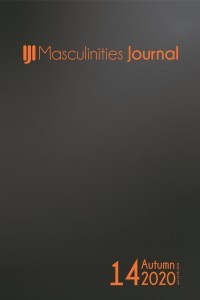Eril Çoğul ve Tekil Olarak Eril. Oscar Wilde, Charles Baudelaire ve Jules Barbey d'Aurevilly: 19. Yüzyılın Erkeklik Prizmasından Yansıyan Üç Züppe
19. yüzyıl toplumun kaçınılmaz bir figürü olarak züppe, cinsel kapasitesi de dahil olmak üzere normatif kategorilendirmenin her şekline karşı hala direnmektedir. Bu çalışmanın bir parçası olarak, biz bu sayı resim, fotoğraf ve karitatür gibi yazılı olmayan kaynaklar üzerinden karşılaştırmaya çabaladık. Bu aynı zamanda Oscar Wilde, Charles Baudelaire ve Jules Barbey d'Aurevilly'nin üç ikonik züppe figürünün analiziyle de sağlanmış oldu. Bu amaçla, ilk olarak 19. Yüzyılda baskın olan erkeklik ve kadınlığın belirleyenlerini ortaya çıkardık. İkincil olarak, bu projede kullanılan her imajda bu belirleyenleri tespit etmeye çalıştık. Wilde'ın farklı temsillerinin analizinin de literatürü desteklediğini gördük. İrlandalı yazar literatürde de belirtildiği üzere züppenin androjenliğini çok güzel somutlaştırıyordu. Charles Baudelaire ve Jules Barbey d'Aurevilly'in kullandığı dikkatimizi çeken imajlarda ise toplumsal cinsiyet oluşumu açısından yaşanan bir kriz öne çıkmıyordu. Diğer yandan, bu portreler üzerinden bir analiz yapıldığında, erkekliğe üç farklı bakışın da ortaya çıktığını saptadık.
Anahtar Kelimeler:
Züppelik, erkeklik, erillik, gerileme, cinsel kimlik
Masculine Plural and Singularly Masculine. Oscar Wilde, Charles Baudelaire and Jules Barbey d'Aurevilly: Three Dandies Seen Through the Prism of the Masculinity of the Nineteenth Century
An inescapable figure of nineteenth-century society, the dandy still resists any form of normative categorization, and including in his capacity as a sexual being. As part of this research, we endeavoured to compare this assertion with the non-written sources that are portraits through the media of painting, photography and caricature. This was also done by examining three iconic figures of dandyism, i.e. Oscar Wilde, Charles Baudelaire and Jules Barbey d'Aurevilly. To do this, as a first step, we sought to establish the markers of masculinity and femininity that prevailed in the nineteenth century. In a second step, we tried to identify these markers in each of the images used for this project. The analysis of different representations of Wilde corroborates the literature. The Irish author perfectly embodies the androgyny of the dandy as stated in the literature. As regards Charles Baudelaire and Jules Barbey d'Aurevilly, the images that caught our attention failed to highlight the existence of an identity crisis in terms of gender. On the other hand, we were able to establish, through scrutiny of these portraits, three different attitudes to masculinity.
Keywords:
Dandyism, Masculinity, Virility, Decadence, Sexual identity,
___
- Badinter, Elizabeth, XY De l'identité masculine, Paris : Editions Odile Jacob, 1992, 31. Print
- Barbey d'Aurevilly, Jules, Les Bas bleus, Paris : Victor Palmé, 1878, 19. Print
- Bertaud, Jean-Paul. L'armée et le brevet de virilité», Corbin, Alain (dir.), op. cit, 63-79. Print. And Roynette, Odile. « L'uniforme militaire au XIXe siécle : une fabrique du masculin Femmes et Sociétés, 36 (2012) : 109-129. Print.
- Defeyt, Antoine, Masculine plural and singularly masculine. Oscar Wilde, Charles Baudelaire and Jules Barbey d' Aurevilly : three dandies seen through the prism Of the masculinity Of the nineteenth cen tury, Brussels: IJLB, 2013. Print.
- Guillet, Franpis. « Le duel et la défense de l'honneur viril Corbin, Alain (dir.), Histoire de la virilité, 2. Le XIXe siécle, Paris : Seuil, 2011, 83 124. Print
- Mosse, George, L'image de l'homme. L'invention de la virilité moderne, Paris : Editions Abbeville, 1997, 12. Print.
- Oakley, Ann, Sex, gender and society, Londres : Maurice Temple Smith, 1972. Print
- Revenin, Régis. « Conceptions et théories savantes de l'homosexualité masculine en France, de la monarchie de juillet la premiere guerre mondiale Revue d'HistOire des Sciences Humaines, 2.17 (2007) : 23 45. Print
- Sinfield, Alan, The Wilde century, Effeminacy, Oscar Wilde and the queer moment, London: Cassel, 1994, Il. Print.
- Partridge, John Bernard, "Fancy portrait", Punch, or the London Charivari, 102 (5 March 1892): 113. Print.
- Perrot, Philippe, Le travail des apparences ou les transformations du corps féminin, xvme-wxe siécle, Paris : seuil, 1984, 164. Print.
- Tacium, David, Le dandysme et la crise de l'identité masculine å la fin du XIXéme siécle : Huysmans, Pater, Dossi, Montréal : Université de Montréal, 1998, 8. Print.
- Tamagne, Florence, Mauvais genre ? Une histoire des représentations de l'homosexualité, Paris : La Martiniére, 2001, 102. Print
- Weininger, Otto, Sexe et caractére, Lausanne : L'Age d'homme, 1989 (1903), 73. Print.
- Başlangıç: 2014
- Yayıncı: Eleştirel Erkeklik İncelemeleri İnisiyatifi
Sayıdaki Diğer Makaleler
"Hayır, bu herhangi başka bir aşk gibi değil": Morrissey'in Latin Fanları, Erkeklik ve Sınıf
Ataerki Sadece Kadına mı Baskı Yapar: Sosyal Alanda Erkeklik ve Babalığın Rolü
`Geek'lerin Yükselişi: "The Big Bang Theory"deki (2007) Eril Kimlikleri Keşfetmek
Erkeklik Çalışmalarının Eksik Boyutu: Estetik, Erotik ve Varoluş
Erkekliğin Metalaştırılmasını Sorgulamaya Doğru: Deleuze'ün Kontrol Toplumu ve 'The Big Lebowski'
